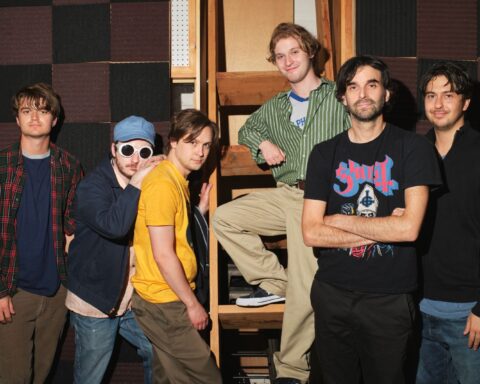Terje Toomistu is the filmmaker of Soviet Hippies, which will have its North American Premiere at the EstDocs Film Festival. The film was produced after Toomistu co-curated a multimedia exhibition about Soviet hippies, which traveled internationally in museums and galleries. She was a Fulbright fellow in UC Berkeley in 2013-2014 and is a visiting researcher at University of Amsterdam while pursuing a PhD in Anthropology at Tartu University. There will be a reception at the Hot Docs Ted Rogers Cinema on Saturday, November 4 at 6:30 PM and a screening at 7:30 PM. To see the complete EstDocs Film Festival programme, view EstDocs.com.
K.P.: Kalli Paakspuu
T.T.: Terje Toomistu
K.P. What inspired you to make this film?
T.T. I’ve been concerned with various practices of resistance since my early teens. In Estonia in the late 1990s there was a kind of war on the streets between the so-called hairy ones and the so-called bald-headed ones. My friends and I were the arty kids into alternative music, activism and music making and these other fellows wanted to show off by using violence. Looking back at it now, they really made trouble for no reason. The memories which emerged in the post-Soviet Estonia where I grew up was usually tied to this trauma.
When I first read the memoirs of Vladimir Wiedemann, who is one of our protagonists in the documentary, it blew my mind, because I didn’t have any idea that in the Soviet Union there was this wild counterculture—-people with whom I might share quite a bit for keeping up their spirit of resistance and belief. That was the beginning of the film for me.
K.P. While the American hippies protested the Vietnam war and rejected decadent consumer values, the Soviet hippies were turned against a state that enforced conformity. Yet the Soviet hippies used the Vietnam war to organize a grass roots campaign. Can you tell us more about this?
T.T. The hippies in the Soviet Union had already been around for a few years, until some of them felt it was time to get more active and demonstrate to the wider public that hippies existed in USSR and had something to say. As hippies were naturally pacifists, a public act against the Vietnam War fitted quite well with their ideals. It also seemed to be a legitimate reason for the authorities (remember the Cold War context!) to grant permission for a public protest march. So on the 1st of June in 1971 a couple of thousand hippies in Moscow came together, but things didn’t turn out quite as expected. Basically, it was a trap set by the authorities to grab all the hairy fellows at once, after which the creepy silent systematic repressions followed. This pushed the movement deeper underground and made it far more radical.
K.P. In the first sequences in your film Soviet Hippies, the Christian cross figured prominently. Was Christianity linked with freedom? Why did you choose this iconography for your introductory sequence?
T.T. First of all, very little film material survived from that subculture and this particular material was always somehow special for me. We see a collective manifestation here, a ritual, a journey. Indeed, they are walking on the beach following a cross with the pacifist symbol and that in itself already says something. Besides the popular myth of Jesus being the very first hippie, it’s also true that churches were often the hideaway places for Soviet hippies and under the doctrine of state atheism any religious practice was heavily repressed.
Perhaps in Soviet Union more than anywhere else, the beach connoted freedom. As we know, Soviet Union was a closed state where only a few privileged ones could travel. For me, Soviet hippie subjectivity is deeply ingrained with an ‘imaginary elsewhere,” which was not only their perceived West, but also the transcendent experiences, the internal dreamland that the hippies pursued through their spiritual practices, psychoactive substances and sensory experiences generated by music.
The opening image of the film connotes this craving for some promising ‘elsewhere.’
K.P. A Soviet era piece of Communist propaganda shows Estonian children saying they will fight for Communist principles. As you are an Estonian, why is this sequence important to your documentary?
T.T. This is a vow that all the Soviet children had to learn by heart and present at their pioneer initiation. In the documentary it reminds us of the context in which these kids were brought up and where they had to define themselves—against the propaganda, the supremacy of Soviet power and the father-figure of Lenin. Only a very few of them later became hippies.
Interestingly, after seeing the film, several people in Estonia have told me how surprised they are that now, 50 or more years later, they still remember this vow, word for word.
K.P. Can you tell us more about how much impact the hippie movement had on Estonians? Was it different from the other Soviet ethnic groups? And if so, how?
T.T. For me, the hippie movement is not a fixed circle of people and identities, but rather a wave or vibration. Surely there were people working in arts, animation, and music in Estonia that were influenced by this wave and who contributed to the more twisted scenes in Soviet Estonia. Some examples are visible in the documentary. I would highlight bands such as Keldriline Heli, Suuk, Mess, Ornament, Psycho; multimedia art like the works of Kaarel Kurismaa; animation as seen in the works of Rein Raamat, Avo Paistik, Ando Kesküla, and the work of graphic illustrators such as Aili Vint and Vello Vinn.
Soviet Estonia certainly stood out for its more vibrant music scene that attracted hippies from across the Soviet Union. The movie, hopefully, pays a tribute to some of that scene. Archival research was the most challenging part of the filmmaking. Since officially there were no hippies in the Soviet Union, there’s almost no evidence in the official media archives. I had to look into personal archives. But very few people could afford (and could get) a camera and this was also one of the first things that the police or KGB would take away from the hippies. After a few years of searching and asking around, some archives started to slowly, slowly appear, sometimes in the most unexpected ways. Once, I had to visit a museum in L.A. Another time, I received a Facebook message from a stranger promising a mysterious box in Moscow that had to be personally collected.
K.P. In the documentaries about the Soviet Union on Netflix today in Canada, many ethnic groups in the Soviet Union are presented as Russian. Can you tell us how impactful Soviet politics was for the indigenous communities?
T.T. The Soviet Union was a project that colonized politically and culturally more than hundred smaller indigenous communities, not only states such as the Baltics or Ukraine. Russians form just one of the ethnic groups in Russia, yet it is the dominant one. Interestingly, two-thirds of Russia’s territory is inhabited by rather small yet crucial and varied indigenous people, who during the Soviet era were suffering from Sovietisation and lately from the extraction economy, poverty and lack of legal protection and support.
K.P. Freedom to be human was one of the stated principles of one of the Soviet hippies you featured. Can you say anything about the difference between the Soviet hippies and the western hippies? Certainly long hair and a beard had a different value in the west.
T.T. Freedom to be human was certainly the prevailing value among hippies, both in the east and west. Another was pacifism. While in America it was most vocally stated against the war in Vietnam, in the Soviet Union the hippies were concerned about any practice of violent imposition, on the level of state politics, as well as in their everyday lives. And there was plenty of that: from propaganda to a nagging bureaucracy to militarism to surveillance to arrests to harassment to imprisonment to treatments in mental hospitals. The Big Brother kept a terrifying eye on things.
And that’s when hair came into play as this was the most visible marker of the so-called unwanted element in the society. Many hippies experienced forceful cutting of their hair. Eventually hair really became the flag of freedom for the hippie: a political statement or a hidden practice of pride.
That is also why we never heard about the Soviet hippie movement before. Far different from their counterparts in the West, it was hidden from the public eye. It was the underground secret network of those who believed in peace and love as the key organizing principles of their lives.
As we might know, the hippie movement in the west was highly influenced by the consumption of LSD, which was totally absent from the Soviet hippie arena. It seems to me that the movement here was much more sober and intellectual or spiritual. But, for sure, there were also experimentation with mind-altering substances. After all, it catered to the sense of imaginary elsewhere.
K.P. American beat writings like On the Road and Howl became motifs for the Soviet hippies. How influential were the beat poets of the West?
T.T. In a way, our hippiedom got its initial kick from the movement in the west. Pieces of information that leaked through the Iron Curtain inspired the youth profoundly and created an imaginary bond with the global rebellious youth. But by the late 1970s, the movement grew into a subculture of it’s own. It was not anymore a mimic of the western hippie movement; it was something unique with its own slang language, places to gather in each city, rituals, distinct elements of style, and knowledge of survival.
K.P. How unified was this movement in the indigenous communities within the Soviet Union? Are these cultural connections still vital today?
T.T. The Soviet hippie movement was like a network, or rather, something that Gilles Deleuze would call rhizome. I don’t think there was anyone close to understanding the vastness and complexity of this movement. Yet the friendships that were made still hold a very special status in their lives today, since ‘trust’ had quite a different meaning in the Soviet era. More recently, social media has played a good role in connecting the people again. I was also pleasantly surprised that my research, the exhibition and the collaborative filmmaking process has given another positive contribution to bringing these people together and revitalizing friendships.








